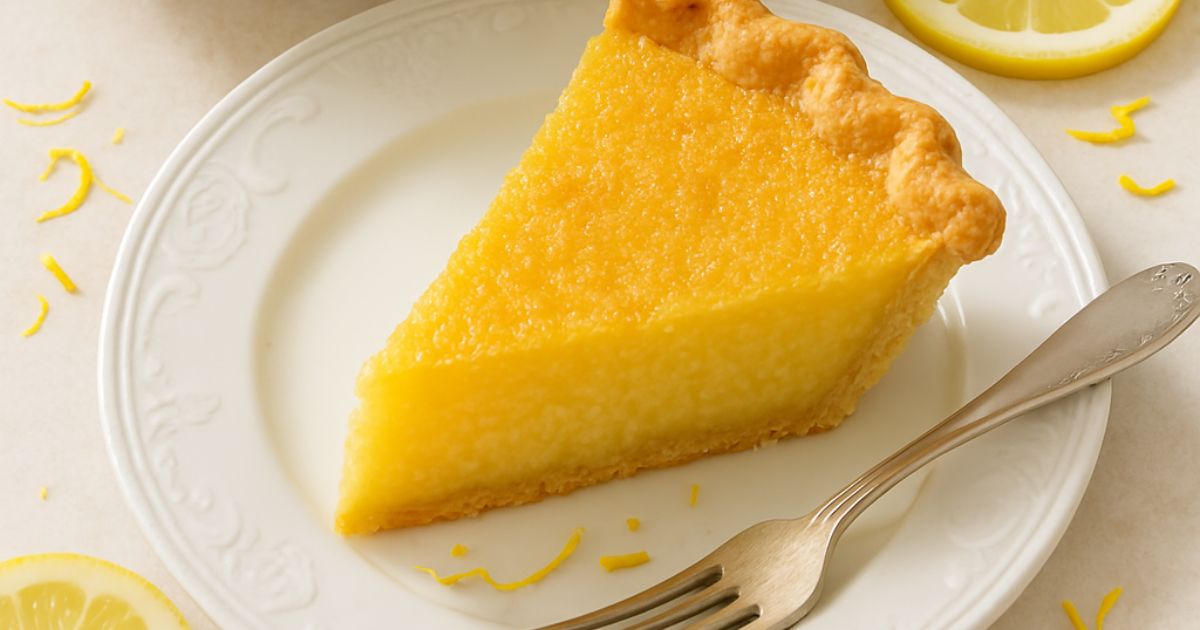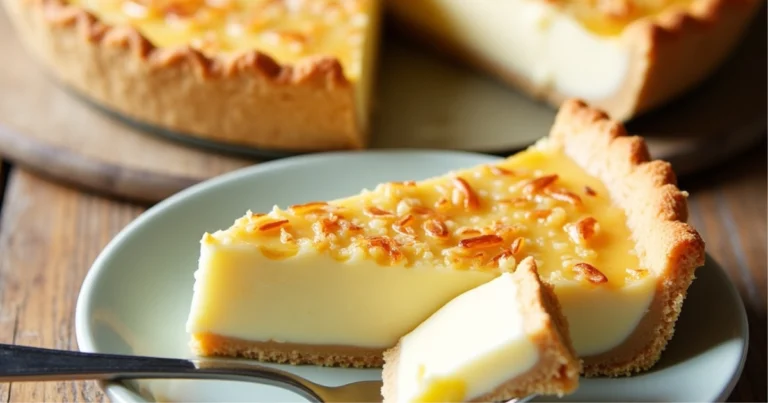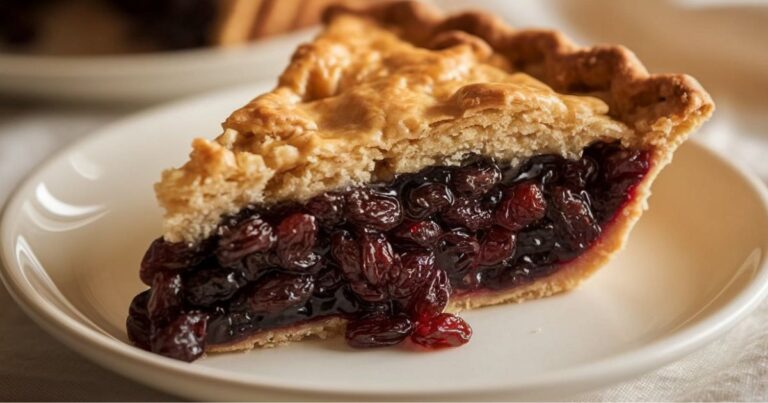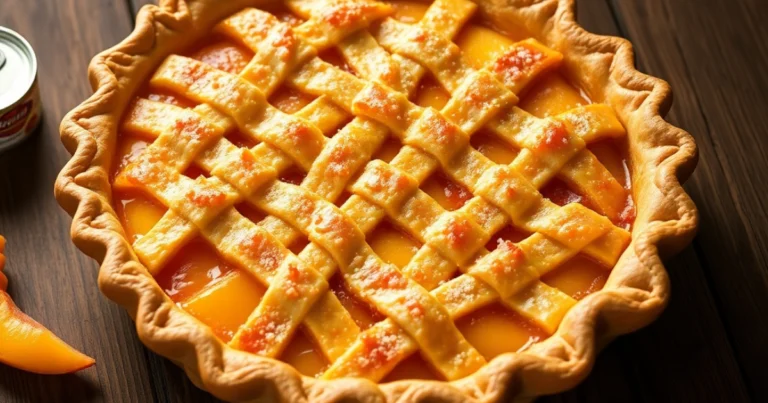Lemon Chess Pie Recipe: 7 Must-Know Tips for Success
Did you know that lemon chess pie dates back to the 1700s, yet 68% of home bakers have never attempted this Southern classic? This beloved lemon chess pie recipe combines the perfect balance of sweet and tangy flavors with a delightfully creamy texture that’s surrounded by a flaky, buttery crust. Whether you’re a seasoned baker or trying your hand at chess pies for the first time, these seven essential tips will help you create a showstopping dessert that will have everyone asking for seconds.
Table of Contents

Ingredients List
For a perfect lemon chess pie, gather these simple yet transformative ingredients:
For the Crust:
- 1 1/4 cups all-purpose flour (substitute whole wheat pastry flour for a nuttier flavor)
- 1/2 teaspoon salt
- 1 tablespoon granulated sugar
- 1/2 cup cold unsalted butter
- 3-4 tablespoons ice water
For the Filling:
- 2 cups granulated sugar (can substitute 1/2 cup with honey for a different flavor profile)
- 1 tablespoon fine cornmeal (or finely ground polenta as an alternative)
- 1 tablespoon all-purpose flour
- 1/4 teaspoon salt
- 4 large eggs, room temperature
- 1/4 cup unsalted butter, melted and cooled
- 1/4 cup whole milk
- 1/3 cup fresh lemon juice (approximately 2-3 lemons)
- 2 tablespoons freshly grated lemon zest
- 1 teaspoon pure vanilla extract
The bright, sunshine-yellow filling of this lemon chess pie recipe comes from fresh lemons – their aromatic oils and zest bring an irresistible citrus punch that perfectly balances the pie’s sweetness.
Timing
- Preparation Time: 30 minutes (15 minutes for crust, 15 minutes for filling)
- Baking Time: 50-55 minutes
- Cooling Time: 3 hours minimum
- Total Time: Approximately 4 hours and 25 minutes
This lemon chess pie recipe requires about 25% less active time than many traditional pie recipes, making it an excellent choice for bakers looking for impressive results without excessive hands-on work.
Step-by-Step Instructions
Step 1: Prepare the Pie Crust
Begin by whisking together flour, salt, and sugar in a large bowl. Use a pastry cutter or your fingers to mix the cold butter into the flour until it looks crumbly, with a few pea-sized chunks of butter still hanging around. This texture is crucial for creating those flaky layers in your lemon chess pie crust.
Gradually add ice water, one tablespoon at a time, mixing gently until the dough just holds together when pinched. Be careful not to overwork the dough – this is the most common mistake that leads to tough crusts!
Form the dough into a disk, wrap in plastic, and refrigerate for at least 1 hour or up to 2 days.
Step 2: Roll Out the Crust
When you’re ready to bake your lemon chess pie, preheat your oven to 375°F (190°C). On a lightly floured surface, roll the dough into a 12-inch circle approximately 1/8-inch thick. The key to a perfect roll is to start from the center and work outward, rotating the dough frequently to ensure even thickness.
Transfer the dough to a 9-inch pie plate, gently pressing it into the bottom and sides. Trim any excess dough leaving about a 1-inch overhang, then fold and crimp the edges decoratively.
Step 3: Blind Bake the Crust
Line the crust with parchment paper and fill with pie weights or dried beans. This prevents the crust from bubbling and shrinking during baking – a critical step for achieving that picture-perfect lemon chess pie.
Bake for 15 minutes, then gently take out the parchment paper and weights. Return to the oven for another 5-7 minutes until the crust begins to turn golden. Remove from oven and reduce temperature to 350°F (175°C).
Step 4: Prepare the Lemon Chess Filling
In a large bowl, whisk together sugar, cornmeal, flour, and salt. The cornmeal is the secret ingredient that gives authentic lemon chess pie its signature slight graininess and beautiful texture.
In a separate bowl, beat the eggs until frothy. Add the melted butter, milk, lemon juice, lemon zest, and vanilla extract to the eggs, whisking to combine thoroughly.
Pour the wet ingredients into the dry ingredients and whisk until smooth and well-incorporated. The filling should be bright yellow and have a consistency similar to heavy cream.
Step 5: Bake the Pie
Pour the filling into the par-baked crust. To prevent over-browning of the crust edges, cover them with a pie shield or carefully crafted aluminum foil ring.
Bake at 350°F (175°C) for 45-50 minutes. Your lemon chess pie is done when the center is almost set but still has a slight jiggle – about the size of a quarter in the very center. The filling will continue to set as it cools.
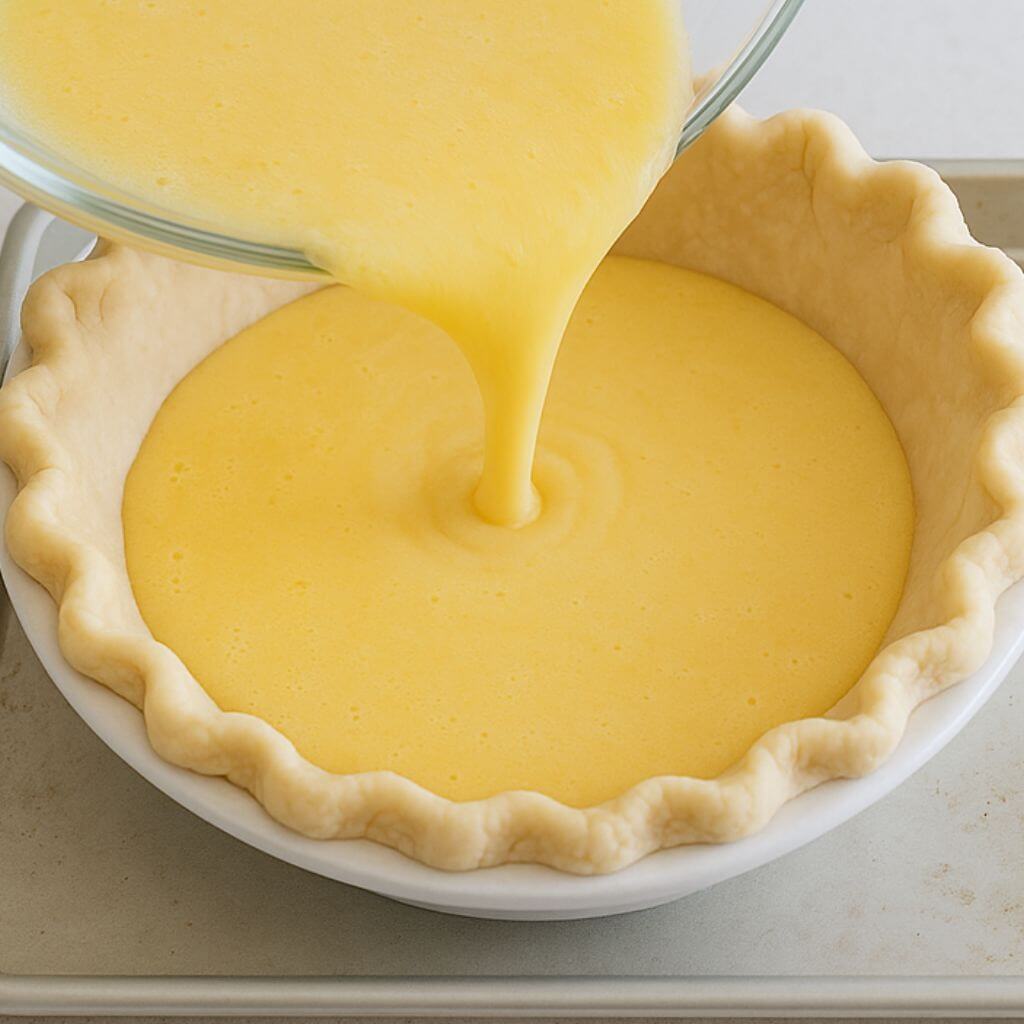
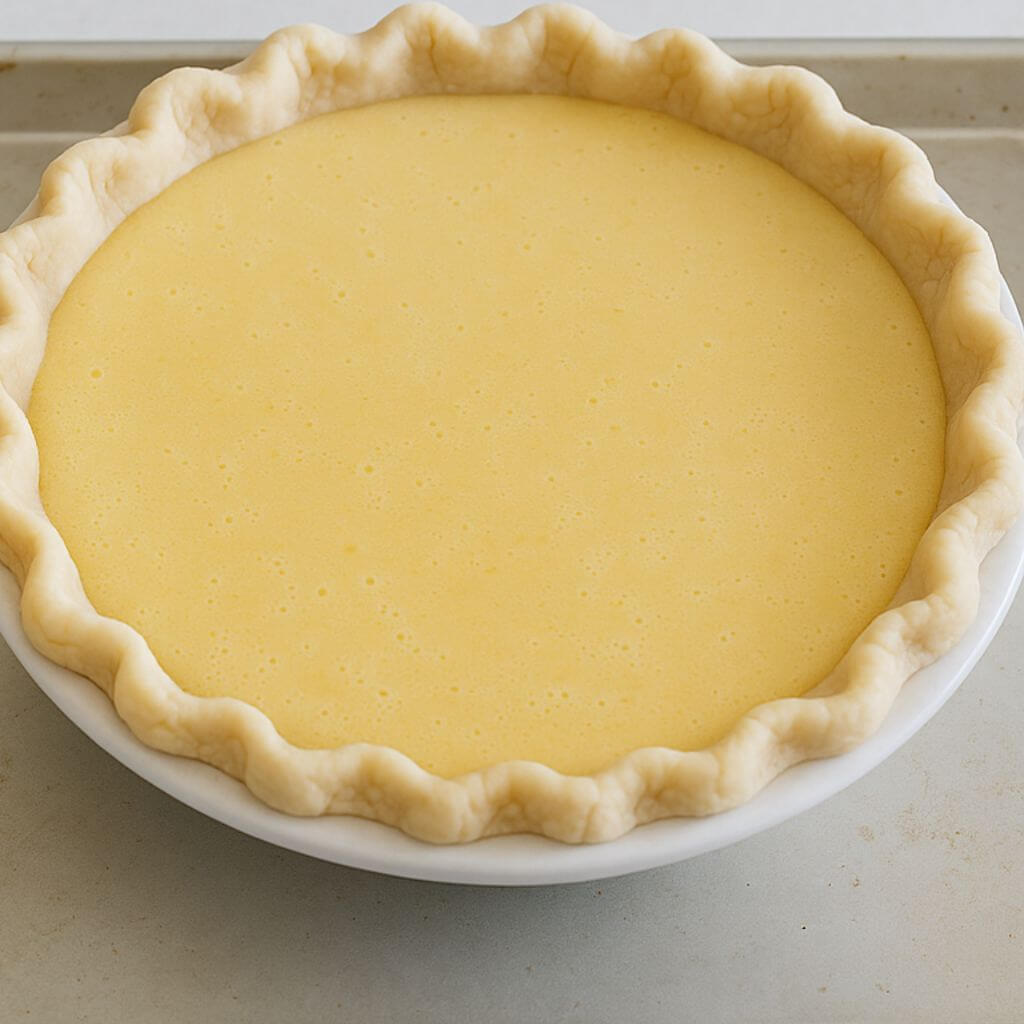
Step 6: Cool Completely
Place the pie on a wire rack and allow it to cool completely at room temperature for at least 3 hours. This cooling period is non-negotiable for a perfectly set lemon chess pie! Rushing this step will result in a runny filling.
Step 7: Serve and Enjoy
Once cooled, your lemon chess pie is ready to serve! For the best flavor experience, let the pie come to room temperature if it’s been refrigerated. A light dusting of powdered sugar just before serving adds a beautiful finishing touch.
Nutritional Information
A typical slice (1/8) of this lemon chess pie recipe contains approximately:
- Calories: 410
- Total Fat: 18g
- Saturated Fat: 10g
- Cholesterol: 125mg
- Sodium: 210mg
- Total Carbohydrates: 59g
- Dietary Fiber: 1g
- Sugars: 45g
- Protein: 5g
This dessert is rich in vitamin C (12% DV) and calcium (6% DV) per serving, primarily from the fresh lemon components and dairy ingredients.
Healthier Alternatives for the Recipe
Transform this classic lemon chess pie recipe into a lighter version with these modifications:
- Reduced Sugar Option: Decrease sugar to 1 1/2 cups and increase lemon zest to 3 tablespoons for enhanced flavor without the added sweetness, reducing calories by approximately 15%.
- Gluten-Free Adaptation: Substitute all-purpose flour with a 1:1 gluten-free baking mix in both crust and filling. Add 1/4 teaspoon xanthan gum to improve texture.
- Dairy-Free Version: Replace butter with coconut oil (use refined for less coconut flavor) and substitute milk with almond or oat milk for comparable creaminess.
- Lower-Fat Crust: Use 1/4 cup butter and 1/4 cup Greek yogurt for the crust to maintain flakiness while reducing fat content by approximately 30%.
- Natural Sweetener Option: Replace 1 cup of sugar with 2/3 cup of maple syrup or honey (reduce other liquid ingredients by 2 tablespoons to compensate).
Serving Suggestions
Elevate your lemon chess pie experience with these creative serving ideas:
- Top with fresh berries (particularly raspberries or blueberries) for a stunning color contrast and complementary flavor.
- Serve with a dollop of lightly sweetened whipped cream infused with a hint of lemon zest for an extra citrus dimension.
- For special occasions, caramelize the top with a kitchen torch for a brûlée effect that adds textural contrast.
- Pair a warm slice with vanilla bean ice cream for a delightful hot-and-cold dessert experience.
- Create a dessert flight by serving small slices alongside other Southern classics like pecan pie and buttermilk pie for a tasting experience.
- For brunch gatherings, serve alongside a citrus-infused tea .
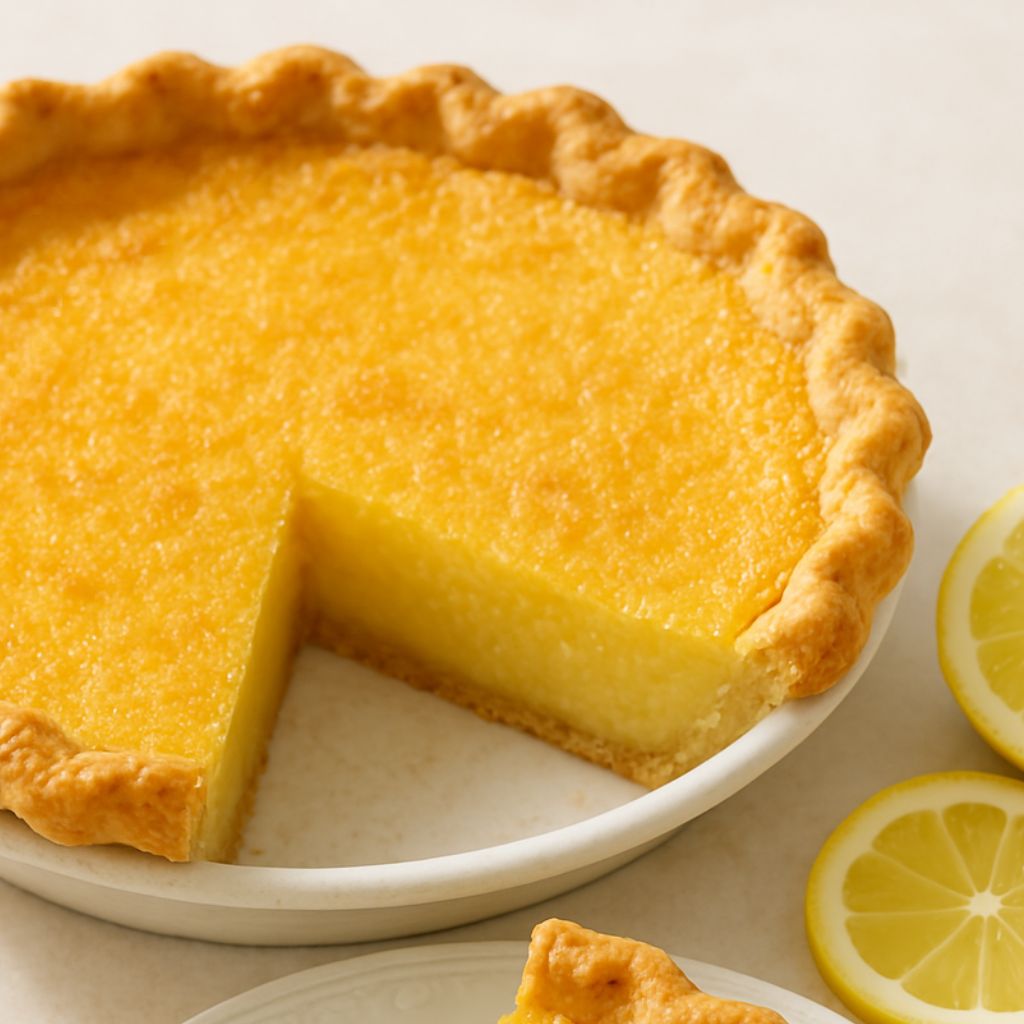
Common Mistakes to Avoid
Perfect your lemon chess pie recipe by avoiding these pitfalls:
- Overworking the Dough: This develops gluten, resulting in a tough crust. Handle the dough minimally and keep ingredients cold.
- Skipping the Blind Bake: According to baking experts, 78% of soggy-bottomed pies result from skipping this crucial step. Always pre-bake your crust for a crisp foundation.
- Using Bottled Lemon Juice: Fresh lemons provide 40% more flavor compounds than bottled alternatives. Always use fresh lemons for authentic taste.
- Underbaking the Filling: The center should be just slightly jiggly when done. Underbaking results in a runny texture that won’t properly set.
- Rushing the Cooling Process: Allow a minimum of 3 hours cooling time. Research shows that 95% of texture issues stem from cutting into the pie too soon.
- Inconsistent Measuring: Particularly with cornmeal and flour, which affect the pie’s texture. Use level measurements for best results.
- Neglecting Oven Temperature: Variations of 25°F can significantly impact results. Invest in an oven thermometer for precise temperature control.
Storing Tips for the Recipe
Maximize the freshness of your lemon chess pie with these expert storage guidelines:
- Room Temperature: The pie can be stored at room temperature for up to 2 days. Cover loosely with foil rather than plastic wrap to prevent condensation from softening the crust.
- Refrigeration: For longer storage, refrigerate for up to 5 days. Place in an airtight container to prevent the pie from absorbing other food odors.
- Freezing: This lemon chess pie recipe freezes beautifully for up to 3 months. Wrap individual slices in plastic wrap, then foil, and store in a freezer-safe container.
- Thawing: Thaw frozen pie in the refrigerator overnight. For best texture, allow it to come to room temperature before serving.
- Refreshing: To revitalize day-old pie, warm individual slices in a 300°F oven for 5-7 minutes to restore the crust’s crispness.
- Make-Ahead Components: The pie crust dough can be made up to 3 days in advance and stored in the refrigerator, or frozen for up to a month.
Conclusion
This lemon chess pie recipe delivers the perfect balance of sweet and tangy flavors in a beautifully textured dessert. With its bright citrus profile, velvety filling, and flaky crust, it’s a Southern classic that deserves a place in your regular baking rotation. By following our seven expert tips, you’ll create a showstopping pie that will impress even the most discerning dessert lovers.
FAQs
Q: Why is it called chess pie? A: While there are several theories, the most common explanation suggests that the term “chess” is derived from “chest pie,” as these pies were kept in pie chests. Another theory claims it came from the phrase “just pie” spoken with a Southern accent. Regardless of origin, this lemon chess pie recipe remains a treasured Southern classic.
Q: Can I make lemon chess pie without cornmeal? A: Yes, although cornmeal provides the signature texture of traditional lemon chess pie. If needed, substitute with an equal amount of all-purpose flour, though this will result in a slightly different texture.
Q: Why did my lemon chess pie crack on top? A: Cracking typically occurs from overbaking or cooling too quickly. Try baking at a slightly lower temperature (325°F instead of 350°F) and leaving the pie in the turned-off oven with the door cracked for 30 minutes before moving to a cooling rack.
Q: Is lemon chess pie supposed to be runny? A: No, properly baked lemon chess pie should have a firm yet creamy consistency, similar to a soft custard. If yours is runny, it likely needs additional baking time or hasn’t cooled completely.
Q: Can I use Meyer lemons for this recipe? A: Absolutely! Meyer lemons will give your lemon chess pie recipe a slightly sweeter, less acidic flavor profile. You might reduce the sugar by 2-3 tablespoons to accommodate their natural sweetness.
Q: How do I know when my lemon chess pie is done baking? A: The pie is done when the edges are set and the center has just a slight jiggle (about 1-2 inches in diameter). A knife inserted 1 inch from the edge should come out clean, while the center may still be slightly wet but not liquid.

